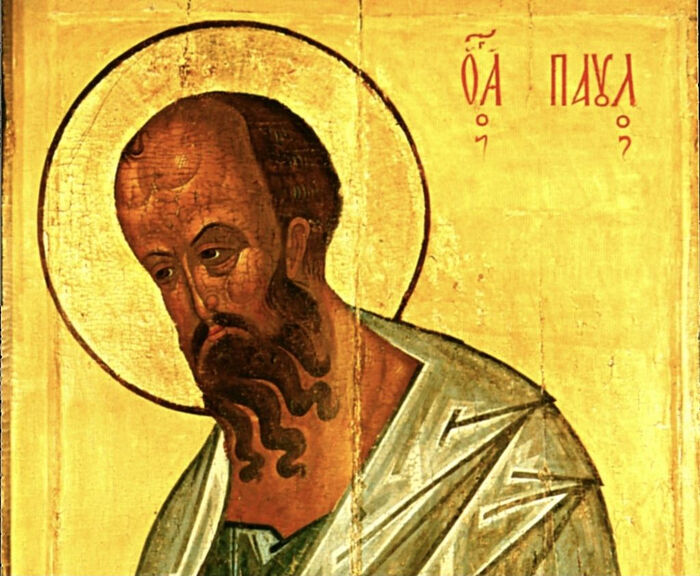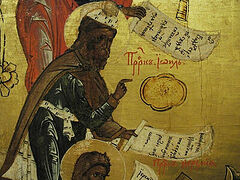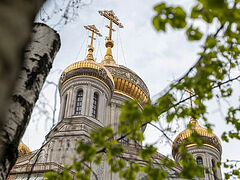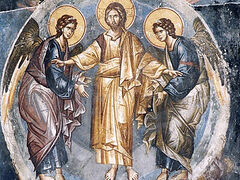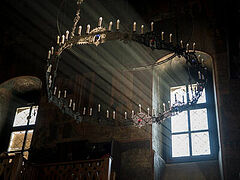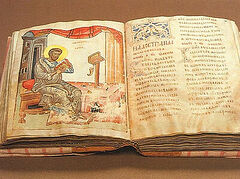We continue our talks on the Book of Acts with Sergei Komarov, a well-known catechist based in Moscow.
We already began to examine the speech of the Apostle Peter in the second chapter of the book of Acts. It’s the first homily given by one of the Apostles; the first homily of the Church, in fact. It’s divided into three parts: The first part begins with the words: Ye men of Judaea, and all ye that dwell at Jerusalem! (Acts 2:14), the second part: Ye men of Israel! (2:22); and the third part: Men and brethren! (2:29).
Note that St. Peter doesn’t address the women, although they were there. But here we have to understand the culture of the time. Society was represented by men, and the women were attached to the men. Before marriage, a girl was attached to her father, and when she got married, she was considered the property of her husband. That’s how the ancient patriarchal culture was.
So, there are three parts to this speech. It’s interesting to think about who recorded it. There are different ideas about it. Some believe that someone recorded the speech of the Apostle Peter. Others think his speech is given approximately, according to its main theses. That’s probably how it was—just under the influence of the Holy Spirit and their own memory, the Apostles later recalled this speech. St. Luke obviously questioned eyewitnesses, or perhaps he was there himself.
There’s another opinion from Western Biblical scholars that St. Luke invented this speech and put it into the mouth of St. Peter, but this idea doesn’t correspond to our Tradition.
We’ve already analyzed the first part, where the Apostle Peter uses the words of the prophecy of Joel to explain why the Holy Spirit descended upon the Apostles. Recall that the book of Joel speaks about the invasion of locusts and caterpillars upon Israel. This is an allegorical depiction of pagan troops. It says that if Israel repents, there will be this very outpouring of the Holy Spirit. It also says that the great and terrible Day of the Lord is soon coming.
Several historical periods and several meanings are connected together in the prophecy. This includes the fall of Jerusalem and the end of the world—the Second Coming of Christ—and the outpouring of the Holy Spirit, which marks the beginning of the last times. Thus, St. John the Theologian writes: Little children, it is the last time (1 Jn. 2:18).
Christians, in fact, await this Day of the Lord. When it will be, no one knows. We’re not given to know the times and seasons, but the Church is given certain foreshadowings in the book of Revelation and various apocalyptic places in the New Testament—for example, in the Second Epistle to the Thessalonians, and in other of the Apostles’ epistles. The Church has the “mind of Christ;” it will sense and know when these times will come. But judging by the book of Revelation, the Church will no longer influence the life of the world at that time; it will flee into the desert. Obviously it will be some kind of small remnant that will no longer be forming any kind of state policy; that is, there won’t be any kind of Orthodox states. And we see that things are heading there—there aren’t any Orthodox states now, in fact.
I’d also like to touch on the ending of the first part, verse 21: And it shall come to pass, that whosoever shall call on the name of the Lord shall be saved. Quite an interesting phrase. Does it really mean that any man who remembers the name of God at the end of his sinful life will be immediately saved? No, all commentators unanimously say that calling on the name of the Lord implies a life according to the Lord’s commandments. This refers to a man who calls upon the name of God from his heart, during his lifetime; a man who lives by faith. Although the ancient Fathers had the view that the main feat in the last times would simply be to preserve faith.
There are many episodes in the ancient patericons where the Holy Fathers gather together, talk, and say: “Well, we fulfill the commandments of God, but the Christians of the last times won’t be able to anymore. But if any of them preserve their faith, they’ll exceed all our labors and rise higher than all of us; because the times will be so difficult that even simply preserving faith will be a great feat.” And indeed, we see that it’s coming to that.
Indeed, in principle, we’re no longer capable of the ascetic feasts of the ancient Fathers. Even if someone really makes an effort and starts to do something, it’ll look strange. The Church itself would be wary of him. Most likely, it would be a sign of pride. Man is so corrupted already that God doesn’t give the grace to perform great ascetic feats—otherwise man would become proud and become like a demon.
Of course, there are still ascetic feats, for example, on Mt. Athos and in other monasteries. But as one monk I know said, these are the “reserves1 of Orthodoxy.” But overall, there’s a different picture in the world now. Man is so corrupted from childhood, so weakened by the passions and sin, by his non-Christian upbringing, that to direct his life towards great ascetical struggles is very hard for him; it’s hard for it to be so easy and real as in antiquity… This is most likely already a thing of the past. But we have a different feat, to preserve faith in the world, to live according to the commandments, to not get proud, and not condemn others. This is a great feat.
So, let’s read on.
2:22 Ye men of Israel, hear these words; Jesus of Nazareth, a Man approved of God among you by miracles and wonders and signs, which God did by Him in the midst of you, as ye yourselves also know:
This is a long, ornate sentence, syntactically very laboriously constructed. I’d like to stop and discuss something, but let’s finish the thought.
2:23 Him, being delivered by the determinate counsel and foreknowledge of God, ye have taken, and by wicked hands have crucified and slain:
“Jesus of Nazareth,” St. Peter says. He calls Jesus “of Nazareth.” Why? It’s not an easy question, by the way. Why is Christ called a Nazarene? Let’s recall who the Nazarenes were. They were people who took vows during the Old Testament not to cut their hair, not to drink wine or even grape juice, not to touch the dead, and to lead a specific, harsh and ascetic way of life. The vow could be taken for life, or for a certain period of time.2
Acts 18 talks about how the Apostle Paul shaved his head in Cenchrea as a sign of a vow: And Paul after this tarried there yet a good while, and then took his leave of the brethren, and sailed thence into Syria, and with him Priscilla and Aquila; having shorn his head in Cenchrea: for he had a vow (Аcts 18:18). It was accepted that when a man took the Nazarite vow, he shaved the hair of his head, and he observed this vow until his hair grew back. When the hair grew back, he cut it in Jerusalem and burned it on the altar as a kind of sacrifice to God.
Acts also describes how St. James suggested that St. Paul cover the cost for other people to take this vow (there were several other people there). But it didn’t help St. Paul, and he was arrested anyway (Acts 23). St. James wanted thereby to show everyone that St. Paul also observes the Law, as before, but even this didn’t work.
That’s what the vow was like. But let’s ask ourselves: Did Christ observe these vows? Of course not. He drank wine, He touched dead bodies, and He didn’t lead a particularly ascetic lifestyle. Or maybe He couldn’t cut His hair, and that’s why He’s depicted with long hair in icons? In general, where does this iconographic tradition come from?
The most ancient depiction of the Lord Jesus Christ is found on a coin, a medallion of the second century, with Christ with a beard and long hair. This is an ancient Church tradition, although there were several traditions. For example, anyone who‘s been to the catacombs in Rome has seen that Christ is sometimes depicted there as a beardless youth with short hair. This is an ancient tradition as well. Images of ancient Greek gods, such as Hercules, were adapted for the image of Christ. And Christ was also depicted as such a young, ancient god. But then the tradition of depicting Him with long hair and a beard supplanted all the others. Therefore, He could be called a Nazarite because He had long hair and had such an external appearance.
There are two words used for Christ in the New Testament: “Nazoreos” and “Nazarinos.” “Nazarinos” means Nazarene, that is, a resident of the city of Nazarus. Here there’s no problem. We understand that Christ really lived and grew up there. But “Nazareos” means “Nazarite.” The second chapter of the Gospel of Matthew reads: And He came and dwelt in a city called Nazareth: that it might be fulfilled which was spoken by the Prophets, He shall be called a Nazarene (Mt. 2:23).3 By the way, we don’t find this anywhere in the Prophets. It’s a bit of an exegetical riddle.
Why was Christ called a Nazarene, and the Jews called His teaching the “Nazarene heresy?” Some commentators take the word “Nazoreos” as a synonym for the word “Nazarinos” and don’t even ask this question at all. For example, St. John Chrysostom says that a “Nazorei” is a resident of Nazareth. Others try to sort out this problem. The first version of interpretation belongs to St. Theophylact of Bulgaria and St. Jerome of Stridon. They say that the word “Nazorei” must be understood symbolically, that it means a man dedicated to God, a man sanctified.
I’ll quote St. Theophylact for you: “’Nazorei’ means ‘sanctified’ and as the Christ is holy, it is right that He is called ‘a Nazorei.’ For by many prophets the Lord was called ‘the Holy One of Israel.’” St. Jerome writes that “’Nazorei’ means holy. And all of Sacred Scripture talks about how the Lord will be holy.”
There’s another explanation put forth by Sts. Cyril of Alexandria, Ephraim the Syrian, and Jerome. This group of exegetes recalls a famous episode from the book of Judges. There was a judge-hero named Samson. Before the birth of Samson, an angel said to his mother: For, lo, thou shalt conceive, and bear a son; and no razor shall come on his head: for the child shall be a Nazarite unto God from the womb: and he shall begin to deliver Israel out of the hand of the Philistines (Jud. 13:5).
Does this remind you of anything? The words, lo, thou shalt conceive, and bear a son is the same as the Annunciation of the Most Holy Theotokos. In fact, this is a kind of prophecy, a Messianic prophecy that Samson is a type of the Lord Jesus Christ. The Archangel Gabriel says practically the same words to the Theotokos about the birth of Her Son. Lo, thou shalt conceive, and bear a son, is in the book of Judges, and, Behold, thou shalt conceive in thy womb, and bring forth a Son, is from the Gospel of Luke (Lk. 1:31). He shall begin to deliver Israel out of the hand of the Philistines, is from the book of Judges, and from the Gospel of Matthew: He shall save His people from their sins (Mt. 1:21). Everything here has to do with the Savior.
Further it says in Judges: The child shall be a Nazarite unto God from the womb. The word “Nazarite” in the Greek text is translated from the Hebrew as “Nazir.” The Greeks simply didn’t know how to translate this word, and so they wrote “Nazir.” But if we look in a dictionary of ancient Hebrew, we’ll see that the word “nazir” has at least three meanings:
-
an uncut vine;
-
nazorei [Nazarite];
-
dedicated.
And if we replace “Nazarite” with the first (and main) meaning, we get: “The child shall be an uncut vine unto God from the womb.” And so? The thing is that many of the Prophets spoke about Christ as a “branch” or “rod.” A rod out of the stem of Jesse. For example, Isaiah says: Thy people also shall be all righteous: they shall inherit the land for ever, the branch of My planting, the work of My hands, that I may be glorified (Is. 60:21). Or again: And there shall come forth a rod out of the stem of Jesse, and a Branch shall grow out of his roots (Is. 11:1). But here we must ask: What Hebrew word is used here that’s being translated as “branch” or “rod?” It’s not “nazir,” but the rather similar word “netser.” “Netser” and “nazir” are very similar in Hebrew, differing only by one letter. Therefore, the Evangelist could call Christ a Nazarite not because He’s a Nazarite in the proper sense, but because the Evangelist meant the very “branch” the Prophets wrote about.
And, by the way, didn’t the very word “Nazareth” come from “nazir?” “Nazir”—“Nazorei.” Then, it means the “Branch” was born in the city of “Branch.” “Nazareth” and “netser”—“branch.” St. Cyril of Alexandria writes: “If ‘Nazorei’ is interpreted as ‘holy’ or, according to some, ‘flower,’ then these names could be found in many places. For Daniel names Him the Holy of Holies, and Isaiah—the rod from the root of Jesse and a flower from him. And the Lord Himself speaks about Himself in the Song of Songs: I am the rose of Sharon, and the lily of the valleys (2:1). Blessed Jerome writes: “’Nazorei’ means holy. And that the Lord will be holy, all of Scripture talks about this. We can also say something else: The same words are written in the Hebrew text of the Prophet Isaiah: A branch will come out of the root of Jesse, and a nazorei (netser, branch) will rise from its root.”
So this can be a bit of a philological, etymological prophecy in the Bible. If anyone wants to look into this in more depth, you can read my article, “Why Christ is called Nazarene/Nazarite.”



